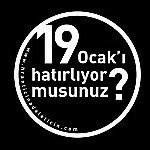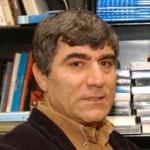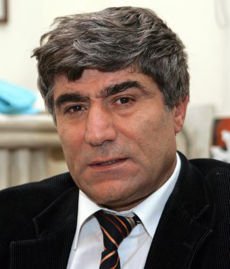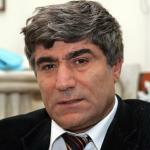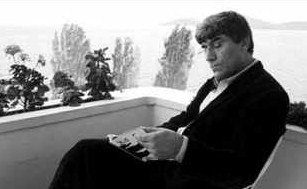Two Years On: Lawyers Summarise Dink Trial

*The murder of Hrant Dink, preparations for his murder, making him a public target, encouraging his murder, the involvement of security forces, the preparation of a hitman and the carrying out of the murder are all part of the same process. However, although this sequence of events needs to be looked at as a whole, it has been separated into parts. Thus, the organs investigating the events are blind to the whole sequence. If the period before and after the murder is not considered together with the murder, then the Hrant Dink murder investigation will not reach any conclusions.
*Security forces and all intelligence units had determined that Hrant Dink’s life was under serious and imminent threat. Intelligence units had even been informed of all the details concerning the murder plan. Nevertheless, no precautions were taken. On the contrary, some public officers tried to cover up evidence and hid information about the gravity of the situation from each other. The gendarmerie, the police force and MIT (Turkish secret service) did not share any information about Hrant Dink’s murder. On the contrary, we have seen that they kept information from each other and, after the murder, accused each other.
*During the investigation, those public officers being investigated continued on active duty. These were people in leading positions, and they were involved in handing in documents for the investigation themselves. That is, the investigation was based on the evidence handed in by those under investigation. This alone shows that the investigation cannot have been independent or reliable.
*Those public officers being investigated did not only offer documents to the administrative investigation, but also to the Istanbul Chief Public Prosecutor’s Office investigating the murder of Hrant Dink. Some of them are even today giving evidence and documents in the court case running at the Istanbul 14th Heavy Penal Court. It is clear that Hrant Dink’s murder will not be solved as long as these officers continue on active duty and are allowed to hand over information, documents and evidence.
Unfortunately, two years after the murder, the above statements still hold true. There have been no positive developments. […]
Main Court Case
The main development in this case, where a total of 19 suspects were on trial last year (8 of them in detention), is that another suspect is on trial. Osman Hayal, the elder brother of suspect Yasin Hayal, has been found to have been in Istanbul on the day of the murder. Initially a witness in the case, he has now been added to the trial as a defendant.
Case No. 2007/428 of the Istanbul 14th Heavy Penal Court is still continuing in the same building because no more suitable building has been found. However, the location has been technically equipped to record the hearings.
In June 2008, following the 18th birthday of the man accused of carrying out the shooting, the court hearings were opened to the public. Since then, the court hearings have been attended by as many members of the public and the press as the location permits.
Demands from our side to combine the separate investigations in Istanbul (where the murder took place), Trabzon (where the hitman and other accused lived) and Samsun (where the hitman was caught) because there have been legal connections and shared activities have been rejected continuously. It is noteworthy that the reasons given for these rejections have not been satisfactory or legal.
Many times, joint attorneys have filed complaints against security forces at the Trabzon and Istanbul Prosecutor’s Offices, the Trabzon Criminal Court of Peace as well as the Istanbul 14th Heavy Penal Court under Article 83 of the Turkish Criminal Law, arguing that members of the security forces knew about plans to kill Hrant Dink, but neither prevented the murder nor protected him. However, after each complaint, both prosecutors and courts ignored the obligations of the law and rejected these complaints with legally unconvincing arguments.
Istanbul Police Force
Following Law 4483, three preliminary investigations against Istanbul police officers were initiated immediately after the murder. However, the regional administrative court put an end to these three investigations with an uncalled for and openly illegal decree.
Investigators commissioned by the Ministry of the Interior sent the case file to experts twice. These expert intelligence officers were asked to write a report on whether Istanbul police officers acted negligently after receiving information sent from Trabzon. Based on the expert opinion, the investigators prepared a report in which they held the whole Istanbul police force, including chief of police Celalettin Cerrah, guilty of negligence.
Although Istanbul police officers claimed they had acted appropriately after the Trabzon police force sent them information on 17 February 2006 (that is, previous to the murder), the expert report and preliminary investigation showed that this was not the case. Measures against Yasin and Osman Hayal were only taken after the murder had been committed. In addition, the experts and investigators expressed their suspicion that fake documents were created to cover up the fact that this only happened after the murder.
Despite these three preliminary investigations and two expert reports, as well as permission for investigation given by the Istanbul governor’s office three times, six police officers, including Istanbul head of intelligence Ahmet İlhan Güler, were exempted from investigation by the Istanbul Regional Administrative Court. The court ignored five folders with thousands of pages of documents, as well as the reports. This court decision forced the joint attorneys to apply to the European Court of Human Rights, as well as to file a complaint against the judges of the administrative court with the Council of Judges and Prosecutors.
Trabzon Police Force
While the Istanbul police force is suspected of knowing all the details of the planned murder and not doing anything to prevent it, and then of obscuring and destroying evidence after the murder, members of the Trabzon police force have also escaped any attribution of blame in the investigations.
The preliminary report prepared under Law 4483, as well as a decree by the Governor’s Province Administrative Council, have found the Trabzon police force to be blameless. Permission to investigate any officer was not given. The objection of the joint attorneys was rejected by the Trabzon Regional Administrative Court in a two-line decree, thus leaving no other options in domestic law.
The Trabzon Chief Prosecutor’s Office decided after its investigation of the Trabzon police force that there was no need for prosecution. When the joint attorneys filed an objection at the Rize Heavy Penal Court, it was rejected. Again, there are no other options in domestic law for the joint attorneys to explore, so they have taken the two cases against the Trabzon police force to the European Court of Human Rights.
Trabzon Gendarmerie Officers
Following a preliminary investigation of officers at the Trabzon gendamerie, two gendarmerie officers, Okan Şimşek and Veysel Şahin, were taken to the Trabzon 2nd Criminal Court of Peace, charged with negligence. In their statements in court on 20 March 2008, the two officers said that they had received intelligence that Yasin Hayal’s brother-in-law Coşkun İğci was going to kill Hrant Dink. They said that they informed their superiors, but that their commander Ali Öz changed the topic, saying, “We will talk about this later”; the topic was never discussed again. Following their statement, other gendarmerie officers were questioned and supported the statement.
The Trabzon 2nd Criminal Court of Peace then sent the file to the Trabzon Prosecution in order to file a complaint against Trabzon Gendarmerie Commander Colonel Ali Öz and other officers. The prosecution combined this file with the complaint filed by the joint attorneys and applied for a preliminary investigation to the Ministry of the Interior. Investigators commissioned by the Ministry decided to initiate an investigation against these officers. The Trabzon Prosecution then prepared an indictment against Ali Öz, Metin Yıldız, Hüseyin Yılmaz, H. Ömer Ünalır, Gazi Günay, Okan Şimşek, Veysel Şahin and Önder Araz and decided to start a trial.
Although the trial of Şimşek and Şahin had raised expectations, it looks as if the state will respond in its usual manner. The Trabzon 2nd Criminal Court of Peace came to the conclusion that the crime could not be considered a simple neglect of duty, and thus sent the file to the Heavy Penal Court to open a trial under Article 83 of Turkish Criminal Law (see above). However, the Criminal Court of First Instance charged with decreeing on this change of courts decided, without offering satisfactory arguments, that the case should continue to be heard at the Criminal Court of Peace.
Samsun Police and Gendarmerie Officers
One development which has shaken people’s trust in the justice system is the acquittal of Samsun police officers. Everyone knows that when Ogün Samast, the man accused of shooting Hrant Dink, was caught in Samsun, he was taken to the police station. Perhaps because he was under 18 years old, he was not taken to the cells, but kept in the tea room. He was with police officers and gendarmerie officers. They queued up to have their photos taken with Samast, posing with a Turkish flag. Special care was also taken to include a calendar with the slogan “The soil of the motherland is holy, and it will not be abandoned” in the pictures. Although these officers treated a murder suspect not like a suspect but like a hero, although they took photos in their official uniforms, and although their identities were known, only two officers were taken to trial. What were they accused of? Of not preventing the pictures from being leaked to the press and of holding the accused in the tea room.
Apart from these two officers, the Samsun Chief Public Prosecutor’s Office has decided that there is no reason for prosecution. Joint attorneys objected to the Çarşamba Heavy Penal Court. Following a rejection of the objection, they were forced to appeal to the European Court of Human Rights.
The two police officers on trial were acquitted by the Samsun 4th Criminal Court of First Instance. The joint attorneys have lodged an appeal.
Report of the Parliamentary Human Rights Committee
The Parliamentary Human Rights Committee has published its report on the Hrant Dink murder. On page 183 of the report, the committee comes to the following conclusions:
“Police and gendarmerie officers knew of a threat to Hrant Dink. He died because notes on this threat were not researched fully and necessary action was not taken. Despite the fact that Coşkun İğci was a registered informant of the Province Gendarmerie Command, information and intelligence coming from him was insufficiently investigated and evaluated. Despite the fact that the administrative units knew about the threat, there was neglect at each stage, and nothing done to prevent the murder.
Article 17 of our constitution and Article 2 of the European Convention on Human Rights states that everyone has a right to life. The state did not fulfill its duty of protecting this right to life.”
This report thus reiterates what all previous investigations found: that all security forces knew about a planned murder of Hrant Dink but did nothing to prevent it.
Prime Ministerial Review Committee
On 2 December 2008, the Prime Ministerial Review Committee prepared a report confirming the findings about the security forces in previous reports. In addition, new information was unearthed. While such new information may seem like a ray of hope, at the same time this information did not come out during the countless previous investigations, and it has not reached the courts dealing with the trials.
In part of the report, it says:
“The Trabzon Province Police Force
received intelligence about a planned murder of Hrant Dink around a year
before. It did not fulfill its duty of investigating the intelligence and
planning an operation and of informing the Istanbul Police Force and the
Intelligence Department.
Similarly, following a letter from the Trabzon Intelligence Unit to the Istanbul Intelligence Unit on 17 February 2006, in which it said that “work on the person are continuing”, as well as a phone conversation between officers of the branches talking about this letter, in which it was said that Istanbul was to be informed of developments, and following a report of 7 April 2006 with additional information, the necessary institutions were not informed.”
“…Despite intelligence information frmo Yasin Hayal that there was a plan to murder Hrant Dink, a letter from Armenian Patriarch Mesrob Mutafyan, death threats made to Hrant Dink, as well as other events during the period that Hrant Dink was on trial, the Istanbul Police Force did nothing towards protecting Hrant Dink and did not show the necessary sensitivity in carrying out its duties.”
Thus, according to the findings of the Review Committee, the Trabzon and Istanbul Police failed to do their duty. The committee also found:
“Despite the fact that, following the letter by the Trabzon Intelligence Unit from 17 February 2006, there was enough information (particularly after the dismissal of informant Erhan Tuncel) to coordinate between the units towards a possible operation, to follow events and to take measures to protect Hrant Dink, we have concluded that C Branch Chief Ali Fuat Yılmazer, who neglected to carry out the necessary evaluations and protective measures outlined in the circular concerning the Programme of Targeted Persons, as well as Ramazan Akyürek and other officers, who acted negligently, despite acting as Central Intelligence Unit deputy chiefs and as Intelligence Unit chief (Akyürek), should be investigated in a preliminary investigation of the Ministry of the Interior, following Law No. 4483.
This report is signed by the Prime Minister, and it remains to be seen what will happen.
[…]
BBP and Nationalist Organisations
Another issue that has to be considered is the suspects on trial are either members of the BBP (Great Unity Party) and the nationalist Alperen Hearths, or, if they are not members, they had a lot of contact with them.
Since 2002, suspect Yasin Hayal always had relations with the Nizam-ı-Alem Hearths, an organisaiton with ideological and political connections to the BBP; he attended meetings and worked there as a teamaker. When the Nizam-ı-Alem Hearths changed their name to Alperen Hearths, this relation continued. When Yasin Hayal beat up the priest of the Santa Maria church, faked bomb alarms, bombed McDonald’s and took part in the planning of Hrant Dink’s murder, he was a member of the BBP.
Suspect Erhan Tuncel was in similar intensive contact with the BBP and the Alperen Hearths; this is where he met Yasin Hayal. Erhan fought for the leadership of the hearth with Mustafa Öztürk. The BBP was also important to him. When the chair of the BBP came to Trabzon, Erhan Tuncel was one of those accompanying him around the city. He was on sufficiently intimate friendly terms with the chair to talk to him about Yasin. According to Erhan’s statements in court, he still has the key to the hearth meeting place.
Mustafa Öztürk was the leader of the Alperen Hearth when the murder was being planned. It is said that the prospective murderers were brought to the hearth and introduced to him, and that details of the plan were discussed there.
When Yaşar Cihan was BBP Trabzon Province party chair, he supported Yasin in prison, both materially and morally. Similarly, Halis Egemen, then BBP central party officer, supported Yasin Hayal and his family after the latter went to prison for bombing McDonald’s.
A recent television programme broadcast on TRT, entitled “The Labyrinth of Shahs”, shows what Hrant Dink represented to the BBP and its supporters. One of the programme advisors appearing on the programme as a witness to the Maraş massacre (1978, over 100 people were killed), Ökkeş Şendiller, is a founder and member of the BBP. He made untruthful and criminal statements, insulting Hrant Dink and, with the party’s racist views, made Armenians a public target yet again. The BBP, with its openly racist and xenophobic ideology, needs to be watched carefully.
As long as politics, language and culture are not cleansed of this racist hatred and violent discourses, and as long as the propagators of such discourses do not face sanctions, there is no guarantee against more such murders being carried out.
Conclusions
*The following question still remains unanswered: Why, despite the findings of the reports of the Parliamentary Human Rights Committee and the Prime Ministerial Review Committee, have those security units who neglected to act on the grave and imminent threat that Hrant Dink was under and did not provide security not been put on trial?
*At this point it has become clear that MIT (secret service), gendarmerie and police did not fulfill their responsibilities, did not cooperate and coordinate, kept information and intelligence from each other, and started to accuse each other in order to shift blame. Although these three organisations are clashing, they are surprisingly united on two issues:
Despite knowing that Hrant Dink would be killed, they were decisive not to do anything to protect him.
They were determined to treat Hrant Dink’s murder suspect(s) as heroes.
*As was pointed out above, investigations carried out in this way will not solve the murder. It is clear, once again, that the time before and after the murder have to be investigated together, and that court cases have to be merged.
*According to information emerging during the trial, Yasin Hayal (involved in planning in the murder), his brother Osman Hayal (who is strongly suspected of being at the crime scene during the murder) and Hrant Dink were all under police surveillance. Similarly, murdered priest Andrea Santoro (killed in Trabzon in 2006) and the three men killed in Malatya in 2007 were all under police surveillance at the time of their murders. It is highly though provoking that the state is able to let people under surveillance be killed, and that the murder suspects, also under surveillance, are not pursued.
*If the state wants to rid itself of responsibility of this murder, it must at least prosecute those in its institutions who have found to be responsible. The justice system must treat all the court cases and investigations as a whole. (FÇ-DT/EÜ/AG)





